Export and import all your user and customer details from and to your WooCommerce store using the Import export Suite for WooCommerce.
Mapping of WooCommerce Users
↑ Back to top| Column Heading | Explanation | Accepted value or format |
|---|---|---|
| ID | Identification Number | Numerical |
| customer_id | Identification Number of the customer. | Numerical |
| user_login | Can include: email, id, name. | Alpha-numeric characters. |
| user_pass | Login password of the user. | Alpha-numeric characters. |
| user_nicename | Slug of the username stored only in the database. This value is not displayed in the user’s details page. | Alpha-numeric characters. |
| user_email | Email address of the user | Alpha-numeric characters. Eg: [email protected] |
| user_url | URL of the user’s website | Alpha-numeric characters. |
| user_registered | Registration date of the user | Numerical |
| display_name | Display name of the user | Alpha-numeric characters. |
| first_name | First name of the user | Alpha-numeric characters. |
| last_name | Last name of the user | Alpha-numeric characters. |
| user_status | Status of the user | Numerical. Wp currently nt using this column 0, 1 |
| roles | Role of the user | Text. Eg: administrator, customer, subscriber |
| nickname | Nickname of the user | Alpha-numeric characters. |
| description | Description or short bio of the user. | Alpha-numeric characters. |
| rich_editing | If the user needs rtf or normal text area. | Text. Eg: TRUE, FALSE |
| syntax_highlighting | Specifies if the syntax highlighting is enabled or not. | Text. Eg: TRUE, FALSE |
| admin_color | Admin theme colour. | Text. |
| use_ssl | Identifies if the user needs https or http. | Yes, no |
| show_admin_bar_front | Specifies if the user needs the top admin bar. | Text. Eg: TRUE, FALSE |
| locale | Local language which the user prefers. English. | Text |
| wp_user_level | Role dependent number of the user. | Numerical |
| show_welcome_panel | Show the first login welcome panel | Text. Eg: Yes, No |
| session_tokens | Session created on login. | Alpha-numeric characters. |
| last_update | Last update made by the user. Updates can be the login and logout actions. | Time stamp |
| billing_first_name | First name of the billing company | Text |
| billing_last_name | Last name of the billing company | Text |
| billing_company | Name of the billing company | Text |
| billing_email | Email address of the billing company | Alpha-numeric characters. |
| billing_phone | Phone number of the billing company | Numerical |
| billing_address_1 | First address of the billing company | Alpha-numeric characters. |
| billing_address_2 | Second address of the billing company | Alpha-numeric characters. |
| billing_postcode | Postcode of the billing company | Numerical |
| billing_city | City of the billing company | Text |
| billing_state | State of the billing company | Text |
| billing_country | Country of the billing company | Text |
| shipping_first_name | First name in the shipping address | Text |
| shipping_last_name | Last name in the shipping address | Text |
| shipping_company | Name of the shipping company | Text |
| shipping_address_1 | First address of the shipping company | Alpha-numeric characters. |
| shipping_address_2shipping_postcode | Second address of the shipping company | Numerical |
| shipping_city | City of the shipping company | Text |
| shipping_state | State of the shipping company | Text |
| shipping_country | Country of the shipping company | Text |
| meta:wc_last_active | Last active | timestamp |
| meta:icl_admin_language | Specifies the WPML admin language which is set as default | Text |
Steps to import users
↑ Back to topTo import WordPress users / WooCommerce customers:
- Navigate through the menu: WooCommerce > Import Export Suite and click on the tab: Import.
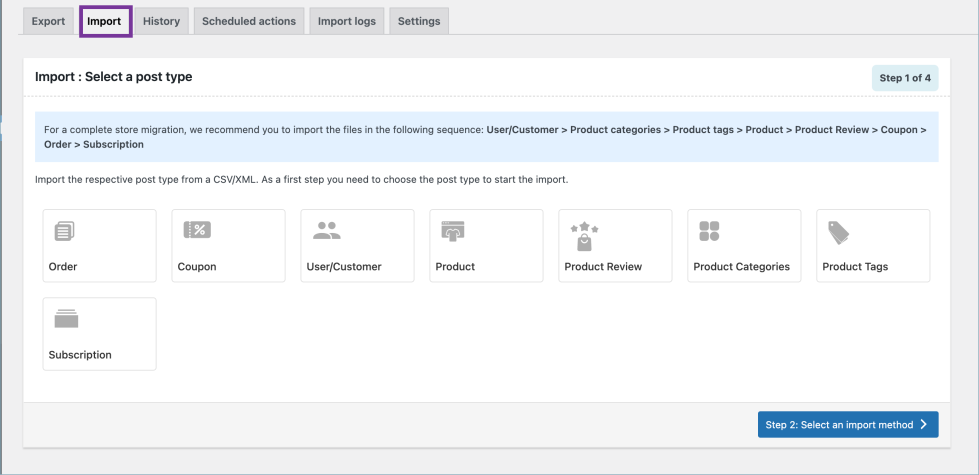
Step 1: Select post type
↑ Back to topAs a first step, you need to choose the post type as Users/Customers.
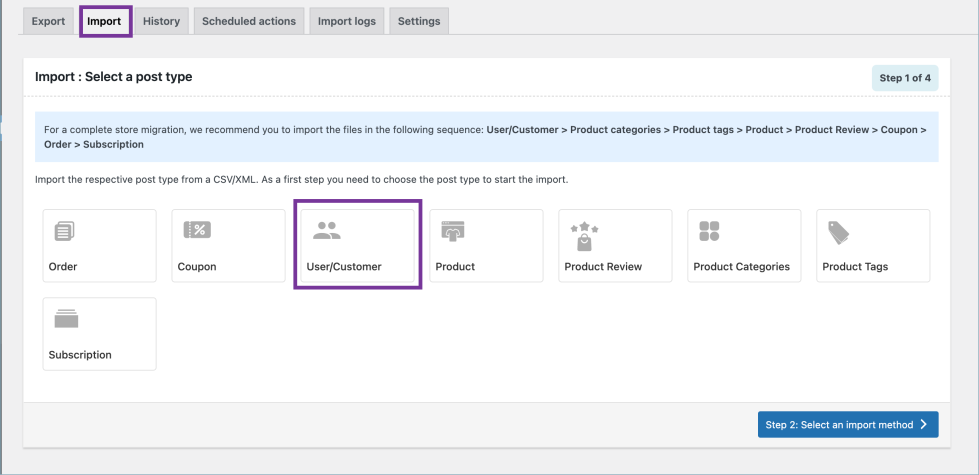
Step 2: Select the import method
↑ Back to topChoose from the below options to continue with your import:
- Quick import
- Pre-saved template
- Advanced import
Let us have a look at each of these import methods:
Quick Import
- imports the basic/standard fields of the respective post type.
- primarily used when your input file was exported using the same plugin
- One can import file from:
- Local
- URL
- FTP
- Click the Import button to complete the action or proceed to Step 3 for advanced options.
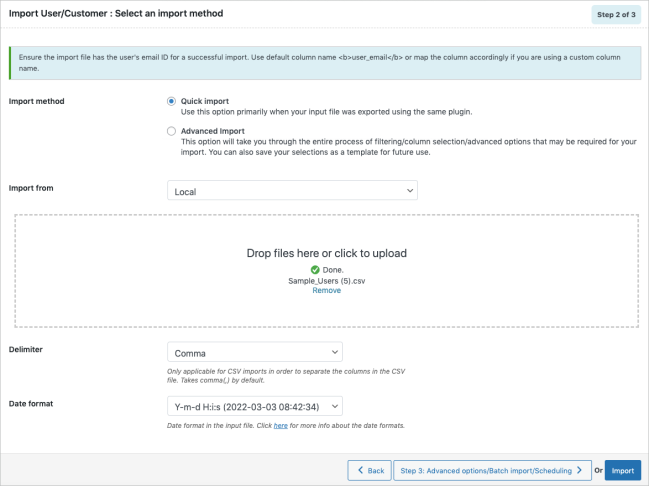
Pre-saved template
- imported data using the Advanced import method in any of your previous imports.
- saved the selections as a template for future use.
This method retains the previous filter criteria and other column specifications as per the chosen file and imports data accordingly. By selecting this option, one can choose a previously saved template from the Import template drop-down.
Note: The template will be listed in the drop down only if you have saved it in previous imports.
If you go through the Advanced import, at Step 4 you will get an option to save the template. Once you save that, next time when you want to import a pre-saved template, it will be populated within the drop down.
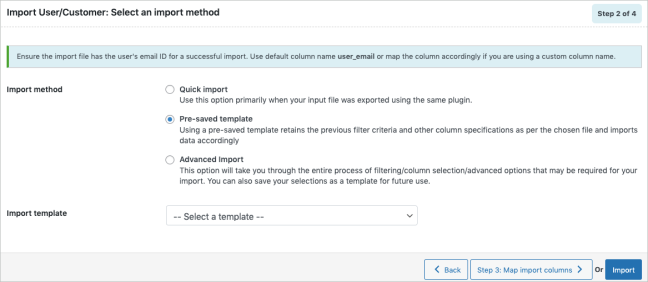
- Click the Import button to complete the action or proceed to Step 3 to map columns.
Advanced Import
This option will take you through a detailed process of filtering/column selection/advanced options that may be required for your import.
Note: You can also save this file as a template for future use.
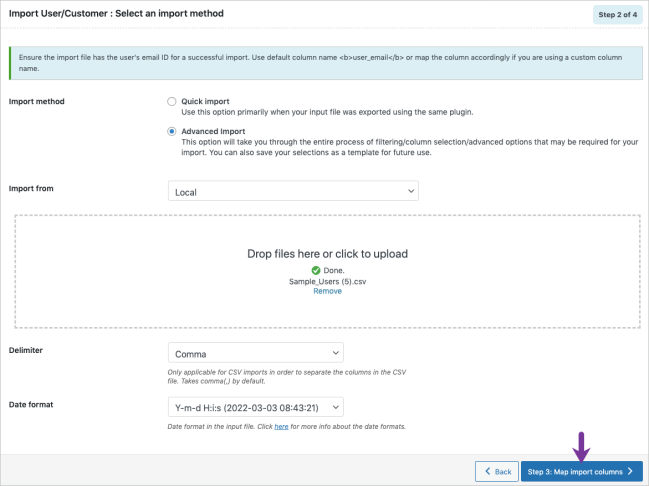
Step 3: Map import columns
↑ Back to top- Here, one can map the import columns under the following 3 fields:
- Default fields: The column names appearing in this section can be edited if required. The preferred names and choices that were last saved can be viewed on choosing a pre-saved template.
- Meta(custom fields)
- Hidden meta

- Click on Step 4 to proceed.
Evaluate field
This field is used to append a value/expression to an existing item while importing. It basically selects/maps any column from the input file and computes the values with expressions and creates output.
- Expression: Any of the operators +*/-()&@ or string constants can be used along with the attributes to manipulate the respective value.
- Input: Select the column from the dropdown which has to be modified.
- Output: Sample value will be created based on the first record from input file.
Note: Columns that have no values in the input file may cause syntax errors if used in an expression.

Step 4: Advanced Options/Batch Import/Scheduling
↑ Back to topOn reaching Step 4, the following window will appear, from where one can:
- Update Only: On selecting “Yes”, the store is updated with the data from the input file only for matching/existing records from the file. On selecting “No”, the entire data from the input file is processed for an update or insert as the case maybe.
- Match users by their: ID, Email, Username
- Existing User: If the user exists in the store, one can either Skip or Update the entry.
- Email new users: One can send email to all the new users upon successful import.
Note: On expanding Advanced options, one can set the number of records that the server will process for every iteration within the configured timeout interval.
If the import fails due to timeout you can lower this number accordingly and try again.
- Save the template file for the future (if needed).
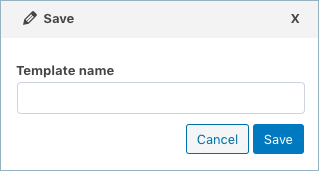
- Click on Import/Schedule to finish.
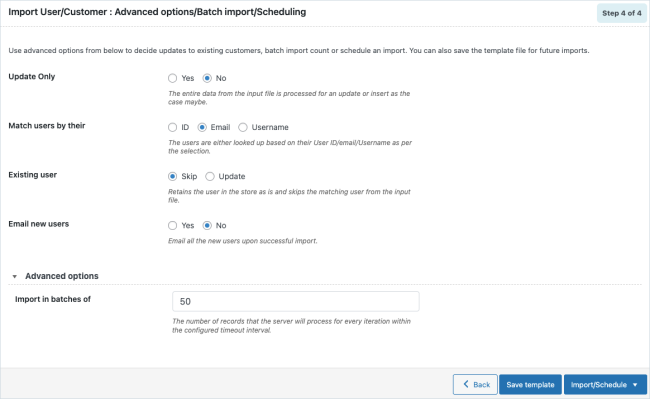
You can either import the users directly into your store or schedule the import.
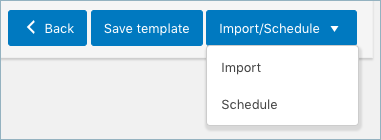
To schedule the import:
- Hit the Schedule option, and you will be taken to the cron schedule window:

The plugin supports two different schedule types:
- WordPress Cron: Upon a visit, WordPress Cron will check to see if the time/date is later than the scheduled event/s, and if it is– it will fire those events.
- schedules your job at the specified time.
- is dependent on your website visitors.
- Server Cron: You may need to trigger the URL every minute depending on the volume of data to be processed. You can use this option :
- to generate a unique URL that can be added to your system in order to trigger the events.
- if you have a separate system to trigger the scheduled events.
Also, the import/export can be scheduled on a daily, weekly, monthly, custom basis.
You can also configure the time at which the import has to be scheduled.
Click on Schedule now to finish.
To directly import:
- Hit on the Import option
Once the import is completed, a pop-up will be displayed showing import status which contains the number of successful imports and failed imports (if any).
Steps to export users
To export WordPress users / WooCommerce customers:
- Navigate through the menu: WooCommerce > Import Export Suite and click on the tab: Export.
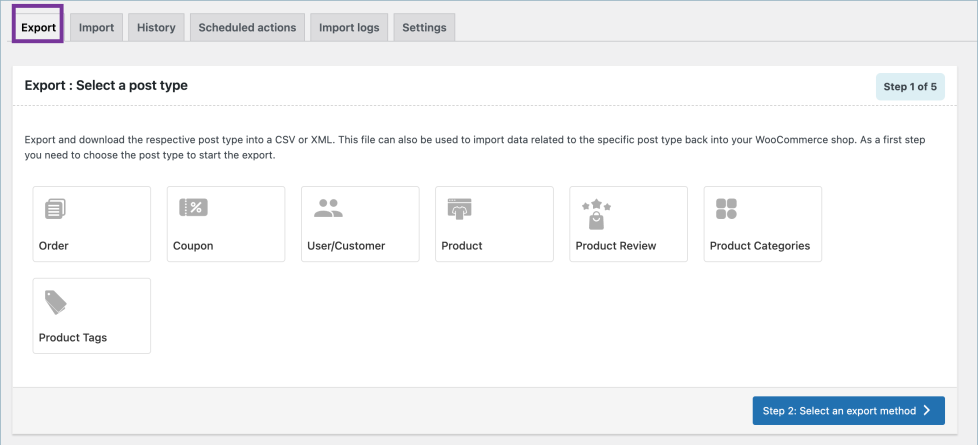
Step 1: Select a post type
↑ Back to topAs a first step, you need to choose the post type as Users/Customers.
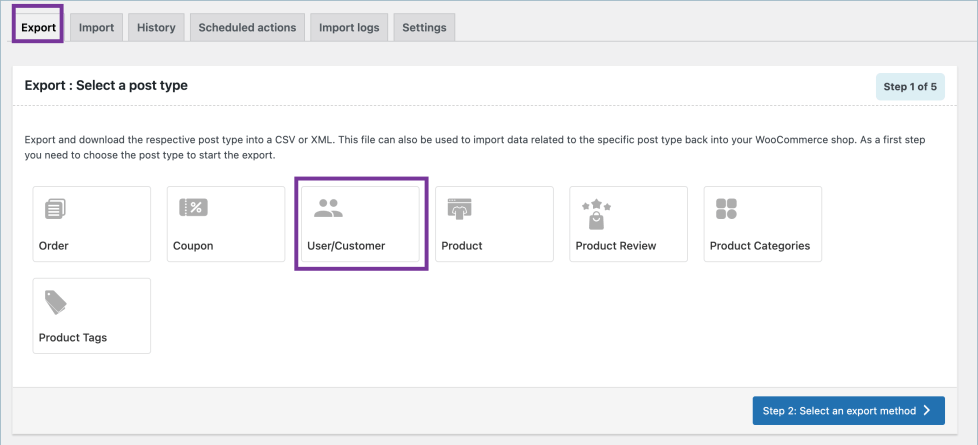
Step 2: Select an export method
↑ Back to topChoose from the below options to continue with your export:
- Quick export
- Pre-saved template
- Advanced export
Let us have a look at each of these export methods:
Quick Export
- Exports the basic/standard fields of the respective post type.
- To include fields from Meta(custom fields) and Hidden meta, select the respective group’s checkboxes.

- Click the Export button to complete the action or proceed to Step 3 for advanced options.
Pre-saved template
- exported data using the Advanced export method in any of your previous exports.
- saved the selections as a template for future use.
Exports data as per the specifications(filters, selective column, mapping.. etc) from the previously saved file. By selecting this option, one can choose a previously saved template from the Export template drop-down.

Note: The template will be listed in the drop down only if you have saved it in previous exports.
If you go through the Advanced export, at Step 5 you will get an option to save the template. Once you save that, next time when you want to export a pre-saved template, it will be populated within the drop down.
- Click the Export button to complete the action or proceed to Step 3 to filter data.
Advanced Export
This option will take you through a detailed process of filtering/column selection/advanced options that may be required for your export.
Note: You can also save this file as a template for future use.

Step 3: Filter data
↑ Back to topClick on Step 3, to view the following window where one can filter data on the basis of:
- Total number of users to export: The actual number of users you want to export. e.g. Entering 500 with a skip count of 10 will export users from 11th to 510th position.
- Skip first n users: Specify the number of users to be skipped from the beginning. e.g. Enter 10 to skip the first 10 users from export.
- User Roles: Input specific roles to export information pertaining to all customers with the respective role/s
- User Email: Input the customer email to export information pertaining to only these customers
- Date From: Date on which the customer registered. Export customers registered on and after the specified date.
- Date To: Export customers registered up to the specified date.
- Sort Columns: Sort the exported data based on the selected columns in the order specified. Defaulted to ascending order.
- Sort By: Defaulted to ascending. Applicable to above-selected columns in the order specified.

- Click on Step 4 to proceed further.
Step 4: Map and reorder export columns
↑ Back to topHere, one can map and reorder the export columns under the following 3 fields:
- Default fields: The column names appearing in this section can be edited if required. The preferred names and choices that were last saved can be viewed on choosing a pre-saved template. One can also move the columns to reorder the arrangement.
- Meta(custom fields)
- Hidden meta
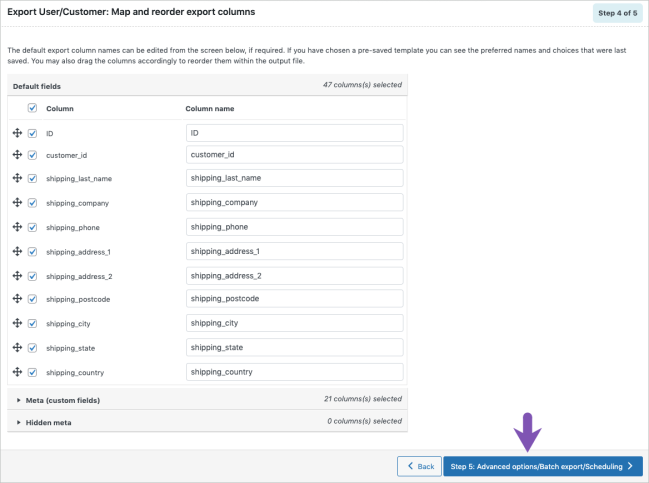
- Click on Step 5 to proceed.
Step 5: Advanced Options/Batch Export/Scheduling
↑ Back to topOn reaching Step 5, the following window will appear, from where one can:
- Export guest users: Exports information related to guest users.
- Export file name: Specify a filename for the exported file. If left blank, the system generates a default name.
- Export file format: Both CSV and XML are available.
- Delimiter: Separator for differentiating the columns in the CSV file. Assumes ‘,’ by default.
- Enable FTP export: On opting ‘Yes’, choose an FTP profile and specify the export path or use default path.
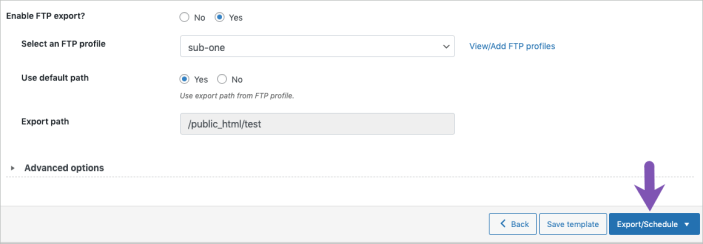
Note: On expanding Advanced options, one can set the number of records that the server will process for every iteration within the configured timeout interval.
If the export fails due to timeout you can lower this number accordingly and try again.
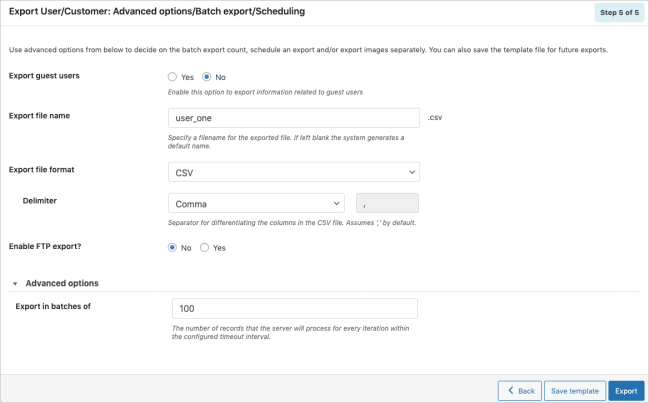
- Save the template file for future export as shown below(if needed).

- Click on Export to export or schedule the export to finish.